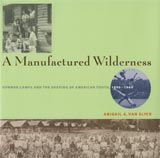Book Review
A Manufactured Wilderness: Summer Camps and the Shaping of American Youth, 1890-1960
By Abigail A. Van Slyck. Minneapolis: University of Minnesota Press, 2006. x + 224 pp., notes, photographs; cloth $34.95.
 |
The Preserve and Play conference held in Chicago, Illinois, in May 2005, was the first national forum to explore and promote ways of preserving recreation and entertainment heritage.(1) From the dedication to her parents "who sent me to camp until I liked it," to the nationwide list of American Camping Association accredited residential camps established before 1960, Abigail A. Van Slyck's book, A Manufactured Wilderness: Summer Camps and the Shaping of American Youth, 1890-1960, is an excellent addition to the growing list of recreation titles that echo many of the themes of that conference. This book is a key reference for anyone interested in the history of social programming and physical planning for children.
Introduced in the 1880s, the North American summer camp concept was part of a return-to-nature trend dating back to the mid-19th century. Like parks, summer camps not only promised relief from the presumed moral and physical degradation of urban life but, as Van Slyck's research reveals, also reinforced white middle-class American values over time.
Van Slyck looked at a fairly narrow range of private camps, camps with religious affiliations, camps organized by social service agencies, and camps sponsored by youth organizations, purposely excluding family, well-baby, and special needs camps. However, the book itself covers a 70-year period during which philosophical currents dramatically transformed American society, especially with regard to youth. Those currents ranged from changing definitions of childhood to medical theories on germs and health, programmed education, the articulation of child play spaces separate from adult work spaces, and approaches on how to safeguard essential childhood experiences for youngsters.
Initially intended to help children reconnect with their "wild or natural" sides, early summer camps mixed age groups and allowed the campers to fill their days as they pleased, with little structure aside from meals and a swim. As American society absorbed new theories on health, childhood, and education, summer camps applied those ideas to the creation of spaces outside the home that catered to the specific needs of children. By the 1920s, summer camps had not only separated ages and provided structured educational and athletic programs, but they had also modified their physical layouts in response to new health concerns and needs. The New Deal era Recreation Demonstration Areas defined a new approach to camp layout based on the "unit plan" and age-appropriate activities. Albert H. Good's three-volume National Park Service study, entitled Park and Recreation Structures (Washington, DC: U.S. Government Printing Office, 1938), had a major influence on camp layout from the moment it appeared in print. Many of the leading national men and women's professional organizations that managed summer camps (YMCA, Boy Scouts, Girl Scouts, Campfire Girls, et cetera) published camp manuals that extensively referenced Park and Recreation Structures.
Van Slyck's book covers six main topics: camp landscapes and changing ideas of childhood; the serious work of play; housing and attitudes towards health; camp mealtime; camp cleanliness; and "playing Indian." The evolution of the physical layout of summer camps—that intersection between natural landscapes, built forms, and social life—coincided with changing ideas of childhood. Fearful that doting mothers might turn the nation's sons into "sissies" and thus undermine the military might of the United States, many camps emphasized adult adventure roles (pioneers, frontiersmen [or women], and Indians) and useful skills (fire building, woodworking). Eventually, they returned to the carefree child concept.
Programmed activities—the serious work of play—are the cornerstones of the camp experience. Early on, camps provided little in the way of programming, but they added structured activities to keep in step with new scientific theories of childhood development. The untrained but eager volunteer camp leader went the way of the dodo bird, replaced by the trained child-development specialist.
Discussions about camp housing, cooking, eating, and sanitation reflected the surfeit of theories on disease prevention and heightened concern for the psychological and emotional well-being of children. Early summer camps emphasized military style mess halls and group preparation of food to encourage social interaction with other campers and camp staff, including camp cooks. Eventually, this mealtime ritual of preparing the food and cleaning up afterwards came to an end: In the interests of the children, camps distanced campers from the "adult work of sanitary food preparation."
Finally, Van Slyck addresses the Native American influence on camp landscapes, from camp names to community-oriented Indian council rings, ritualistic dancing and adornment, encounters with archeology and other educational opportunities, all of which promoted an appreciation of Indian culture while obscuring the impact of white domination on native societies.
This book provides a thorough historical background and expert analysis of the summer camp, which for many people was one of the most formative and memorable of their childhood experiences. This reviewer hopes that Van Slyck's pioneering work will encourage historians to research and write about recreational facilities with an eye towards their continued preservation and use.
Cari Goetcheus
Clemson University
Note
1. The Preserve and Play conference was sponsored by the National Park Service, National Council for Preservation Education, and the Historic Preservation Education Foundation.
